 I decided to read this book not only because I know the author personally, but also because it seemed the kind of fictional historic and political novel I have become fan of.
I decided to read this book not only because I know the author personally, but also because it seemed the kind of fictional historic and political novel I have become fan of.The book follows a part of Neferlöen's life, the 15-year-old adopted daughter of the ruler of one of the so called Terras de Corza (portuguese for Lands of Corza), the king of Levionda. She comes to play a major part in the changes happening in those lands, related to the formation of a new Power (as the different states are called) and to the attacks of an organized group of mercenaries of whom all we know in the beginning is that they wear black and have a typical tattoo on their chest.
Neferlöen is a well developed character, I found myself capable of befriending her halfway through the book and considering how her problems might be solved or guessing what she would do now and then. The geopolitical context is also very interesting, created from scratch, middle-age like, where nobles fight for power and catapults are state of the art. A striking difference with our middle-age is that women's rights in some of the Powers are already somewhat understood and respected.
My main issue with the book was the writing. Madalena Santos was 15 years old when she wrote O Décimo Terceiro Poder, and it shows on the grammatical formality of her writing, mainly during the first half of the book, where sometimes I felt I was reading a text composed for a Portuguese examination. By the end of the book this is fairly less notorious and does leave me interested in her later books.
O Décimo Terceiro Poder is a quick read, but, nonetheless, the story, characters and political emphasis were enticing. I believe the book exists only in Portuguese, so I recommend this for Portuguese speaking readers that enjoy fiction/fantasy and politics.
Ratings(1-10):
Style - 3
Creativity - 6
Entertainment - 7
Relevance - 3
Overall - 5
Ratings(1-10):
Style - 3
Creativity - 6
Entertainment - 7
Relevance - 3
Overall - 5


